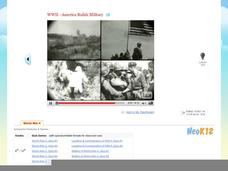Curated OER
Fastest Animals on Earth in Slow Motion - Animal Camera
Watch this video for your chance to see some of the fastest animals on Earth in slow motion. The hydromante salamander is showcased for its fast tongue and the mantis shrimp for its fast and strong punch. With the help of slow motion...
Curated OER
Puffins
Iceland, one of the most volatile locations on Earth, is home to the Atlantic puffin. Unfortunately, due to changes in the environment, puffins are quickly dying. Learn more about Atlantic puffins in Iceland in this fabulous video!
Curated OER
Oceans: Antarctica
Welcome to the coldest, driest, windiest place on Earth: Antarctica. Krill serve as the food to support the entire ecosystem here. It is why fish, seals, whales, and sea birds can exist! Much of this ecosystem has remained a mystery...
Curated OER
How Money is Created?
How much money exists if banks and governments can create it whenever needed? Truth be told, this number is constantly changing. This resource will support your learners' understanding of money circulation with its cartoon...
Curated OER
Whale Shark
The largest species of shark in the ocean is the whale shark. They can weigh up to 10 tons! However, unlike the great white shark, whale sharks have tons of tiny teeth. Learn more about the whale shark in this fantastic video clip!
Curated OER
Volcano 101
Another fantastic video from National Geographic! This one teaches the basics of volcanoes; where they occur, why they occur, the different types of volcanoes, and the benefits and hazards of living nearby an active volcano.
Curated OER
Oceans: Arctic
By 2100, it is projected that nearly all of the Arctic's sea ice will be lost. Explore this region and learn about the effects of global warming on our polar bears, ring seals, whales, and narwhals. What will happen to our arctic sea...
Curated OER
WWII - America Builds Military
A "sleeping giant" through the many German invasions in Europe, America slowly starts participating in the war. First, America sells aircraft to Britain, makes its naval presence known in the Caribbean, and builds its artillery. This...
Curated OER
The Freedom Rides
"We're going on to New Orleans. No matter what happens, we're dedicated to this. We'll take hitting; we'll take beating. We're willing to accept death." In 1960, a group of students, both black and white, journeyed across the south and...
Curated OER
Rockies Thrust Up
How did Colorado's Front Range arise when it's 1,000 miles from where the Pacific and North American plates meet? Learn about the theory behind this oddity and use this video to springboard into other topics, such as what types of rocks...
Curated OER
WWII - Hitler's New Germany
How did Hitler rise to power? Take a look at how Adolf Hitler manipulated the government, the German masses, and his own Nazi leaders to take power of Germany post WWI. An interesting video to introduce your class to Adolf Hitler and his...
Curated OER
Eagle vs. Eagle in Mid-air
Eagles fight for their turf in this exciting video. Wonderfully narrated by National Geographic, this video shows great video footage of the eagle's competitive and territorial habits.
Curated OER
Poisonous Pitcher Plant - The Private Life of Plants
Pitcher plants are one of the largest carnivorous plants. Its prey-trapping mechanism includes a large pitcher-like cavity that fills with liquid, creating a "lethal pond". Check out this video to see how the pitcher plant forms itself...
Curated OER
WWII - US to Arm Allies
Before joining World War II, Franklin D. Roosevelt changed the military policy to lend-lease, meaning that the US would distribute artillery without requiring immediate payment. What are the benefits to changing this policy? What are the...
Curated OER
Avalanches 101
National Geographic videos are so good! This one, on avalanches, is especially well done. In just three minutes, learners should glean a lot of important information on how avalanches occur, the different types of avalanches, and how to...
Curated OER
Exploring Oceans: Great Barrier Reef
All aboard! Let's take a trip to the world's largest living structure, the Great Barrier Reef. Encompassing more than 1,200 miles of islands and reefs, it is considered one of the seven wonders of the natural world due to its...
Curated OER
How Does Your Body Digest Food?
Marshall Brain uses a sponge, rope, and other common household items to display the workings of the digestive system. This resource would definitely hold the attention of a squirrely junior high class!
Curated OER
Enhancing Your Presentation Skills
Watch Doug Jefferys present on presenting skills! From a conference-type venue, Jefferys speaks to an audience about the fear of public speaking and how to overcome it. He indirectly refers to Maslow's hierarchy of needs, making eye...
Curated OER
Ancient Rome: Constantine - Part 5/6
A holy war ensues after the senate attempts to murder Constantine. Then, after neither side secures victory, a seven year-long stretch of peace follows. Still furious and unwilling to accept this change in religious intent, Licentious...
Curated OER
Biomes: Taiga and Tundra
Can you guess the largest biome in the world? It's the taiga, making up almost 30% of the world's forest cover! Use this video to explore both the taiga and the tundra biomes, and take a look into one of the world's greatest phenomenons:...
Curated OER
Solar Thermal Energy: Harnessing the Power of the Sun
A small community in Denmark meets almost all of its energy needs through a solar energy plant. The video explains how solar panels work. Individuals in European countries who have installed solar panels on their homes share the...
Curated OER
WWII - Soviets Launch Counter Attack
Used to the harsh conditions, the Soviet Union's military pushes the German troops back, securing faith for the Soviet people. With German troops freezing and their tanks becoming immobilized, the German troops fell back to take on the...
Curated OER
Evolution Primer #2: Who Was Charles Darwin?
Introduce your young scientists to Charles Darwin, his observations, and how those observations became the basis of the theory of evolution. Use this clip to build an understanding of scientific observation, data collection, and the...
Curated OER
Giant Honey Bees - Life in the Undergrowth
The biggest of all honey bees are shown in this video: the giant honey bee. A brave researcher reaches extremely tall heights to show viewers how the bees protect themselves.

























